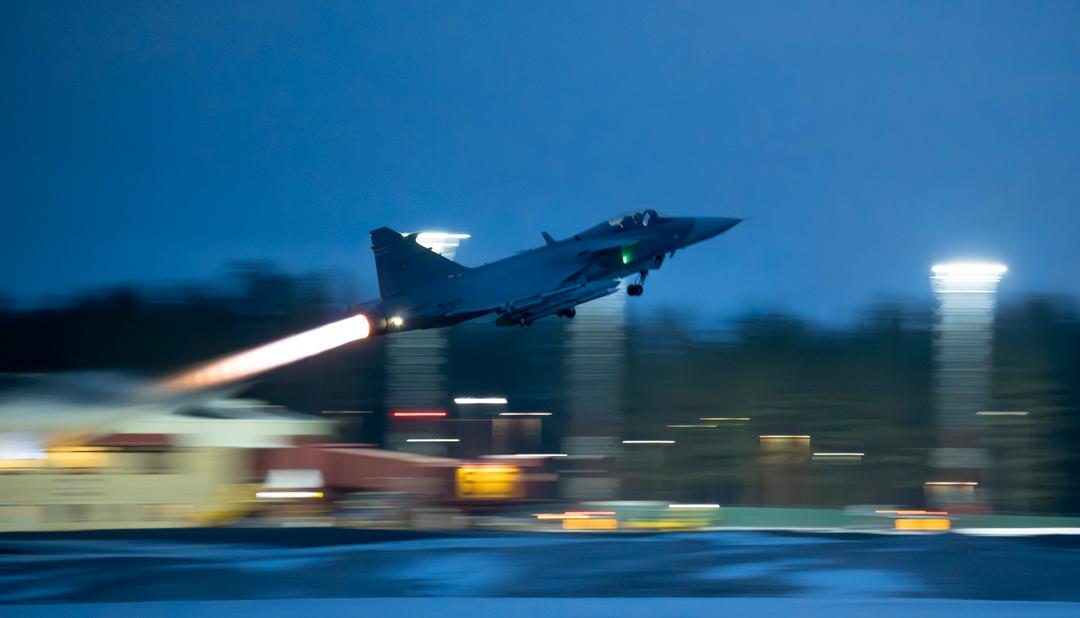GRIPEN: A Swedish fighter plane takes off from Kallax airbase outside Luleå. Photo: Anders Wiklund/TT / TT Nyhetsbyrån / NTB
If Sweden is threatened, the air force can deploy its Jas Gripen fighter jets into deep forests to protect them. In a number of places in the country, wide stretches of national highway are also prepared airstrips for the fighter fleet.
Reporting from Luleå in Sweden on Wednesday 6 March at 08:10
The Norwegian Air Force’s F-35 fighter jets operate from two bases: Ørland and Evenes. Now the management is investigating a dispersion concept to prevent opponents from destroying large parts of the fighter fleet in one place.
– We can spread our fighter planes out to small bases with short runways. It is a concept that Nato has not used, but which the alliance is now studying more closely. Nato realizes that if you leave many combat aircraft idle at a base over time, the risk of attack increases. It is a lesson learned from the Ukraine war, says Peter Greberg to VG.
He is the commander of Norrbotten’s Flygflottilj F21, which operates Jas Gripen combat aircraft and has its home base in the northern Swedish city of Luleå.
During the “Nordic Response 2024” exercise, which is underway in the north of Norway, Sweden and Finland, the Swedish fighter jets will use this dispersion tactic. Finland also has the ability to disperse its combat aircraft, and has used it actively in its defense concept.
CHIEF: Peter Greberg is the head of the Swedish air force’s air base outside Luleå. Photo: Anders Wiklund/TT / TT Nyhetsbyrån / NTB
Now more than 150 reservists have been called up to serve the fighter fleet at these temporary “airfields” around northern Sweden. There they can refuel the fighter planes, maintain them and replenish weapons systems.
Norwegian F-35 aircraft have previously tested such temporary airports in both Sweden and Finland.
– In a crisis, spreading the fleet is a big advantage. And with all three countries in NATO, we will have access to a number of landing sites where the planes can be spread out – and then collect them in the airspace as needed, says the head of the Swedish Air Force, Major General Jonas Wikman.
AERIAL TANKING: An American tanker will support the fighter jets taking part in the major Nato exercise in the coming weeks. Photo: Anders Wiklund/TT / TT Nyhetsbyrån / NTB
Had several hundred
According to Greberg, the Swedish air fleet had several hundred such bases during the Cold War.
– We are a long way from that now. But we are rebuilding the ability to spread the aircraft fleet. During this exercise, it will be from other civilian airports, he says.
While Norwegian fighter planes on the ground are protected by anti-aircraft defenses, the Swedish defense sees the advantage of a combination: anti-aircraft defenses and bomb-proof hangars – shelters – at the permanent bases, and the ability to hide fighter planes on less remote airstrips.
– Through the NATO alliance, we will not only have 250 combat aircraft available together in the Nordics. We also want a large number of landing sites, says Wikman.
Teacher of Sweden
According to Eivind Byre, the Air Force’s communications manager, the Swedish concept is also relevant for the Norwegian Armed Forces:
– We have a lot to learn from Sweden and Finland about diffusion, and we are in the process of developing our own, he says.
– It is based on using airports throughout the Nordics, and motorways where possible, he adds.
The Air Force will not share the list of small airports in question. They do not want to reveal what is the minimum runway for the F-35 aircraft. But Byre says that several of the smaller Norwegian airports could be suitable dispersion bases for Norwegian fighter planes.
2024-03-06 07:10:33
#Spread #Sweden #protects #fighter #planes


